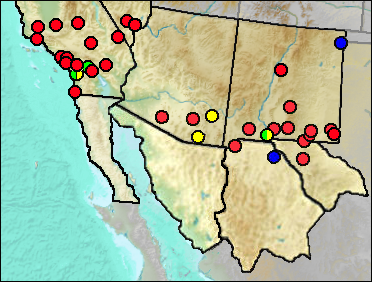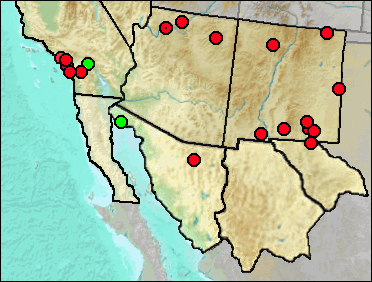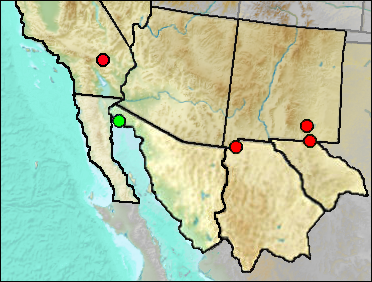Class Mammalia
Order Artiodactyla
Suborder Ruminantia
Family Cervidae
Odocoileus sp.—Odocoileus Deer // Odocoileus hemionus—Mule Deer // Odocoileus virginianus—White-tailed Deer
Two species occur in the region today: Odocoileus hemionus, the Mule Deer, and O. virginianus, the White-tailed Deer. The former occurs throughout the region. The latter is mainly eastern and southern, occurring along the eastern slopes of the eastern mountains in New Mexico and to the east. In northern New Mexico, they were common on the eastern slopes of the Sangre de Cristo Mountains, but rare or absent to the west in the Rio Grande drainage (Findley et al. 1975). A small subspecies occurs in southwestern New Mexico.
The two species differ in the form of the antlers and in some skull features, but generally are otherwise indistinguishable osteologically. The small size of the southwestern subspecies of O. virginianus, however, may allow identification.
Literature.

Cranial and post-cranial material that can be identified as Odocoileus generally can be identified to the species level only with reasonably large portions of antlers or with a very well preserved skull. The result is a number of records at the generic level and relatively few (and somewhat suspect) identifications to species. Deer remains appear to be rarer than would be expected if they were as common in the past as they are today.
Colbert (1950) listed "large cervid" from Ventana Cave, but went on to suggest it might represent one of the western species of Odocoileus which would seem to indicate that it was not large enough for Cervus.
Sites.
Pleistocene: Mina Erupción (Eaton 1923: ?); Perico Creek (Morgan and Lucas 2005: ?).
Late Blancan: Cal Tech (Lindsay 1984); Curtis Ranch (Morgan and White 2005: ?); La Union (Morgan and Lucas 2003); San Simon Fauna (Morgan and White 2005).
Late Blancan/Early Irvingtonian: Elsinore: Mimomys (Pajak et al. 1996).
Irvingtonian: Bautista Badlands (Frick 1921: ?.
Early Irvingtonian: Adobe Ranch (Morgan and Lucas 2005: ?).
Late Irvingtonian: Elsinore: Pauba Formation (Pajak et al. 1996).
Rancholabrean: Bajimari (White et al. 2010); Bitter Springs Playa (Jefferson 2014); Chino (Jefferson 1991b); Corona, California (Jefferson 1991b); Eagle Crest (Jefferson 2014); Fenley Hunter (Jefferson et al. 2015); Jal (Morgan and Lucas 2005); La Botana (White et al. 2010)); Lake View Hot Springs (Jefferson 2014); La Playa (White et al. 2010); Las Vegas Wash, Big Wash (Jefferson et al. 2015); Las Vegas Wash, ESE Indian Springs (Jefferson et al. 2015); Las Vegas Wash, SSE Corn Creek Springs (Jefferson et al. 2015); Los Angeles Police Station (Jefferson 1991b); National City West (Jefferson 2014); Oceanview High School, Seal Beach (Jefferson 1991b); Outfall Sewer, Culver City (Jefferson 1991b); Pinto Basin (Jefferson 2014); Térapa (White et al. 2010: cf.).
Early Rancholabrean: Albuquerque Gravel Pits (Morgan and Lucas 2005).
Sangamon: Naval Fuel Reserve Quarry (Jefferson 1991b).
Wisconsin: Carpinteria (Wilson 1933); Imperial Highway(1991b); San Simon Sink (Harris 1993c: cf.); Zuma Creek (Jefferson 1991b).
Early/Early-Mid Wisconsin: Lost Valley/Rm Vanishing Floor (Harris 1993c: ?); Sabertooth Camel Maze (Harris 1993c: cf.).
Mid Wisconsin: McKittrick (Schultz 1937); U-Bar Cave (Harris 1987).
Mid Wisconsin-Holocene: Shelter Cave (Harris 1993c).
Mid/Late Wisconsin/Holocene: Sierra Diablo Cave (UTEP cf.).
Late Wisconsin: Animal Fair 18-20 ka (Harris 1989); Antelope Cave (Reynolds, Reynolds, Bell, and Pitzer 1991); Big Manhole Cave (Harris 1993c); Charlies Parlor (Harris 1989); China Lake (Jefferson 1991b); Dry Gulch (Morgan and Lucas 2005); Dust Cave (Harris and Hearst 2012); Lower Sloth Cave (Logan 1983); Pendejo Cave (Harris 2003); Potosi Mountain Midden (Jefferson et al. 2015); Steeruwitz Hills #1(4) (Van Devender and Bradley 1990: Cf. gen.); U-Bar Cave 15-18 ka (Harris 1989); Ventana Cave (Colbert 1950: ?); Vulture Cave (Mead and Phillips 1981).
Late Wisconsin/Holocene: Baldy Peak Cave (Harris 1993c); Deadman Cave (Mead et al. 1984); Kokoweef Cave (Reynolds, Reynolds, et al. 1991); Pendejo Cave (Harris 2003); Tule Springs 1 (Jefferson et al. 2015).
Literature.
Colbert 1950;Eaton 1923; Frick 1921; Harris 1987, 1989, 1993c, 2003; Harris and Hearst 2012; Jefferson 1991b, 2014; Jefferson et al. 2015; Lindsay 1984; Lindsay and Tessman 1974; Logan 1983; Mawby 1967; Mead and Phillips 1981; Mead et al. 1984; Morgan and Lucas 2005; Morgan and White 2005; Pajak et al. 1996; Reynolds, Reynolds, et al. 1991; Reynolds, Reynolds, Bell, and Pitzer 1991; Schultz 1937; Van Devender and Bradley 1990; White et al. 2010; Wilson 1933).

Synonyms. Odocoileus cascensis.
Members of the genus Odocoileus are notoriously difficult to identify on post-cranial material or on the absence of specific cranial elements such as antlers or lacrimals.
The Dark Canyon deer (Tebedge 1988) is identified on the basis of a dentary with p3-m3, a lower incisor, and a fragment of a lower molar. He apparently assigned to material to this species since he found no morphological differences from modern Mule Deer material other than slightly larger size of the Dark Canyon material. The Blackwater Draw Fauna specimen was based solely on an upper third premolar (Slaughter 1975).
The Pumphouse Canyon site (Harris 1993c) has been moved from Wisconsin age to Late Wisconsin/Holocene, there being insufficient data to date the site more specifically.
Sites.
Irvingtonian: El Golfo (Croxen et al. 2007: ?).
Early Irvingtonian: El Casco, San Timoteo Badlands (Albright 2000).
?Late Irvingtonian/Rancholabrean: Emery Borrow Pit (Jefferson 1991b).
Rancholabrean: Alameda and Workman streets (Workman Storm Drain) (Jefferson 1991b); Harbor Freeway and 112-113th streets (Jefferson 1991b: cf.); Keams Canyon (Mead et al. 2005); Shea Homes, Laguna Niguel (Jefferson 1991b); Tooth Cave (Mead et al. 2005); White Mesa (Morgan and Rinehart 2007).
Sangamon: Bonito Creek (Jefferson 1991b: cf.); Chandler Sand Pit, Rolling Hills Estates (Jefferson 1991b: cf.); La Brisca (Van Devender et al. 1985); Newport Bay Mesa (Jefferson 1991b: cf.); San Pedro Lumber Co. (Jefferson 1991b).
Mid Wisconsin Glendale (Jefferson et al. 2015); Pendejo Cave (Harris 2003: cf.).
Mid/Late Wisconsin Animal Fair (Harris 1993c: cf.); Dark Canyon Cave (Tebedge 1988); Diamond Valley (Springer et al. 2009); Rancho La Brea (Stock and Harris 1992: cf.).
Late Wisconsin Blackwater Draw (Slaughter 1975); Folsom (Morgan and Lucas 2005); Gypsum Cave (Jefferson et al. 2015); La Mirada (Jefferson 1991b: cf.); Stalag 17 (Harris 1993c: ?).
Late Wisconsin/Holocene: Aden Fumarole (Harris 1993c); Burnet Cave (Schultz and Howard 1935); Stanton's Cave (Olsen and Olsen 1984); Williams Cave (Ayer 1936).
Literature.
Albright 2000; Ayer 1936; Croxen et al. 2007; Harris 1993c, 2003; Jefferson 1991b; Jefferson et al. 2015; Mead et al. 2005; Morgan and Lucas 2005; Morgan and Rinehart 2007; Olsen and Olsen 1984; Schultz and Howard 1935; Slaughter 1975; Springer et al. 2009); Stock and Harris 1992); Tebedge 1988; Van Devender et al. 1985.

The problems involved in identification have been noted elsewhere. Harris' (1993c) record from the Blackwater Draw Fauna is withdrawn; I have been unable to locate a source for the record and suspect it was the result of failing to follow a line accurately across a table.
Sites.
Irvingtonian: El Golfo (Croxen et al. 2007).
Rancholabrean: Campbell Hill (Jefferson 1991b: cf.).
Late Wisconsin: U-Bar Cave 14-15 ka (Harris 1989; cf.).
Late Wisconsin/Holocene: Burnet Cave (Schultz and Howard 1935); Williams Cave (Ayer 1936).
Literature.
Ayer 1936; Croxen et al. 2007; Harris 1989; Jefferson 1991b; Schultz and Howard 1935.
Last Update: 27 May 2015